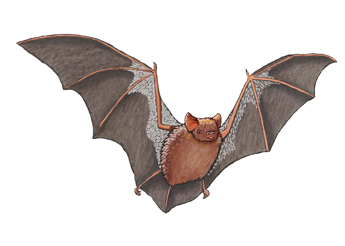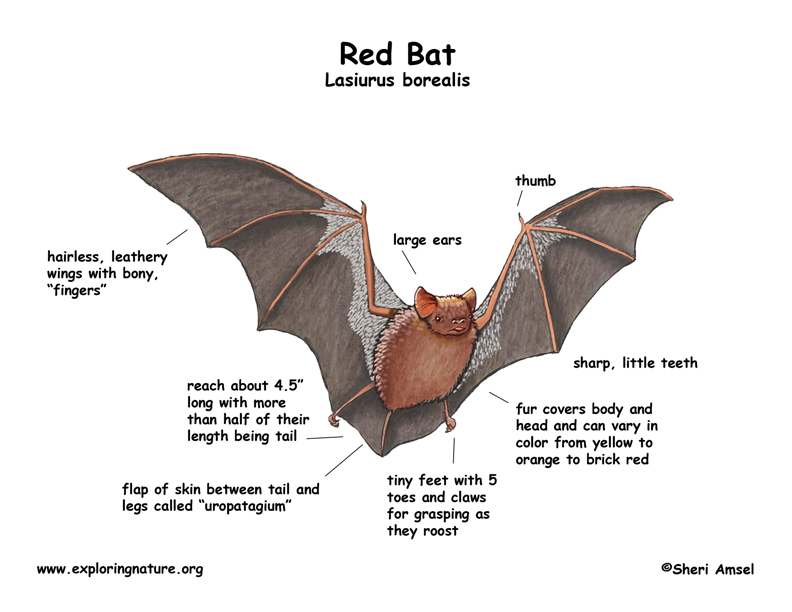

They are found in the eastern and southwestern U.S.
They roost (sleep during the day) in thick leafy trees in deciduous forests of oak, box elder, cottonwoods, etc. They can also be found in more urban parks.
Their fur color can vary from yellow to orange to brick red and is white tipped giving them a frosted appearance. They reach about 4.5” long with more than half of their length being tail. There is a flap of skin that stretched between the legs and tail called the uropatagium. They have sharp, little teeth for crunching insect bodies.
They migrate to warmer climates in winter, though still hibernate during the coldest months when insects are scarce. They are often found hibernating in hollow trees. In summer they roost in the thick leaves of deciduous trees. They use echolocation to locate and catch prey in the dark. Echolocation is a kind of radar that uses the bat’s high-pitched calls to bounce off objects. They can actually “see” what is around them by how their calls bounce off their surroundings.
They eat insects, flying around light sources night where moths and other nocturnal insects gather. They also eat grasshoppers, crickets and other small insects.
These bats mostly fall prey to human activities. They are hit by cars, electrocuted by bug zappers, get caught in fencing, etc.
They mate in the fall, but females store the sperm until spring when they become pregnant for about 3 months (gestation). They can have up to 4 young, but usually have just 2. They feed them milk for up to 5 weeks when the babies begin to fly and can chase insects for themselves.
They can live up to 8 years in the wild. They are not a threatened species.
Related Resources:
High Resolution Diagram
Kingdom: Animalia
Phylum: Chordata
Subphylum: Vertebrata
Class: Mammalia
Order: Chiroptera
Family: Vespertilionidae
Subfamily: Vespertilioninae
Genus: Lasiurus
Species: Lasiurus borealis
When you research information you must cite the reference. Citing for websites is different from citing from books, magazines and periodicals. The style of citing shown here is from the MLA Style Citations (Modern Language Association).
When citing a WEBSITE the general format is as follows.
Author Last Name, First Name(s). "Title: Subtitle of Part of Web Page, if appropriate." Title: Subtitle: Section of Page if appropriate. Sponsoring/Publishing Agency, If Given. Additional significant descriptive information. Date of Electronic Publication or other Date, such as Last Updated. Day Month Year of access < URL >.
Amsel, Sheri. "Bat (Red) " Exploring Nature Educational Resource ©2005-2024. March 25, 2024
< http://www.exploringnature.org/db/view/461 >

